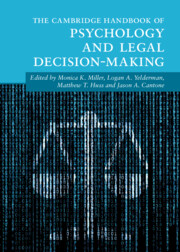Book contents
- The Cambridge Handbook of Psychology and Legal Decision-Making
- Cambridge Handbooks in Psychology
- The Cambridge Handbook of Psychology and Legal Decision-Making
- Copyright page
- Dedication
- Contents
- Figures
- Tables
- Editors
- Contributors
- Part I Introduction Chapters
- Part II Pretrial Phase Decision-Making
- 5 Victim Decision-Making
- 6 Bystanders’ Crime Reporting Decisions
- 7 Pretrial Publicity’s Effects on Jurors’ and Judges’ Decisions
- 8 Police Decisions Involved in Collecting Eyewitness Identification Evidence
- 9 Decisions Related to Miranda Rights
- 10 Judges’ Daubert Decisions
- 11 The Psychology of Confession Decision-Making During Police Interrogation
- 12 Plea Bargaining
- 13 Forensic Science Decision-Making
- 14 Decision-Making by Forensic Mental Health Evaluators
- 15 Interviewing Suspects in Criminal Investigations
- 16 Prosecutorial Decision-Making in Cases of Child Sexual Abuse
- 17 Decision-Making About Restoration of Defendants Who Are Incompetent to Stand Trial
- 18 Clinical Decision-Making Regarding Criminal Responsibility
- 19 Decision-Making Regarding Child Victims and Witnesses
- Part III Trial Phase Decision-Making
- Part IV Postconviction Phase Decisions
- Part V Other Legal Decision-Making
- Part VI Perspectives from the Field
- Part VII Conclusion
- Index
- References
16 - Prosecutorial Decision-Making in Cases of Child Sexual Abuse
Lessons from Australia
from Part II - Pretrial Phase Decision-Making
Published online by Cambridge University Press: 22 February 2024
- The Cambridge Handbook of Psychology and Legal Decision-Making
- Cambridge Handbooks in Psychology
- The Cambridge Handbook of Psychology and Legal Decision-Making
- Copyright page
- Dedication
- Contents
- Figures
- Tables
- Editors
- Contributors
- Part I Introduction Chapters
- Part II Pretrial Phase Decision-Making
- 5 Victim Decision-Making
- 6 Bystanders’ Crime Reporting Decisions
- 7 Pretrial Publicity’s Effects on Jurors’ and Judges’ Decisions
- 8 Police Decisions Involved in Collecting Eyewitness Identification Evidence
- 9 Decisions Related to Miranda Rights
- 10 Judges’ Daubert Decisions
- 11 The Psychology of Confession Decision-Making During Police Interrogation
- 12 Plea Bargaining
- 13 Forensic Science Decision-Making
- 14 Decision-Making by Forensic Mental Health Evaluators
- 15 Interviewing Suspects in Criminal Investigations
- 16 Prosecutorial Decision-Making in Cases of Child Sexual Abuse
- 17 Decision-Making About Restoration of Defendants Who Are Incompetent to Stand Trial
- 18 Clinical Decision-Making Regarding Criminal Responsibility
- 19 Decision-Making Regarding Child Victims and Witnesses
- Part III Trial Phase Decision-Making
- Part IV Postconviction Phase Decisions
- Part V Other Legal Decision-Making
- Part VI Perspectives from the Field
- Part VII Conclusion
- Index
- References
Summary
Prosecutors’ decisions in common law jurisdictions remain understudied. Drawing on examples in Australian cases of child sexual abuse, this chapter provides insights into case attrition or advancement at the discretion of the prosecution. We discuss contextual factors that support this expanding area of prosecutorial practice, including legislation, available special measures for vulnerable complainants, and recommendations of the Australian Royal Commission into Institutional Responses to Child Sexual Abuse. We review factors that influence decisions on charges, whether a case proceeds, plea negotiation, jury versus judge-alone trials, and joint trials. These factors include the age difference between complainants and offenders, the time lapse between alleged offending and reporting, the quality of prerecorded interviews, and the amount of evidence. Recent research and developments affecting decisions by prosecutors about evidence by the complainant and expert witnesses in CSA trials are summarized. We conclude with suggestions for future research to expand understanding of the role of prosecutors’ decisions in this discrete area of criminal justice process.
- Type
- Chapter
- Information
- The Cambridge Handbook of Psychology and Legal Decision-Making , pp. 240 - 258Publisher: Cambridge University PressPrint publication year: 2024

